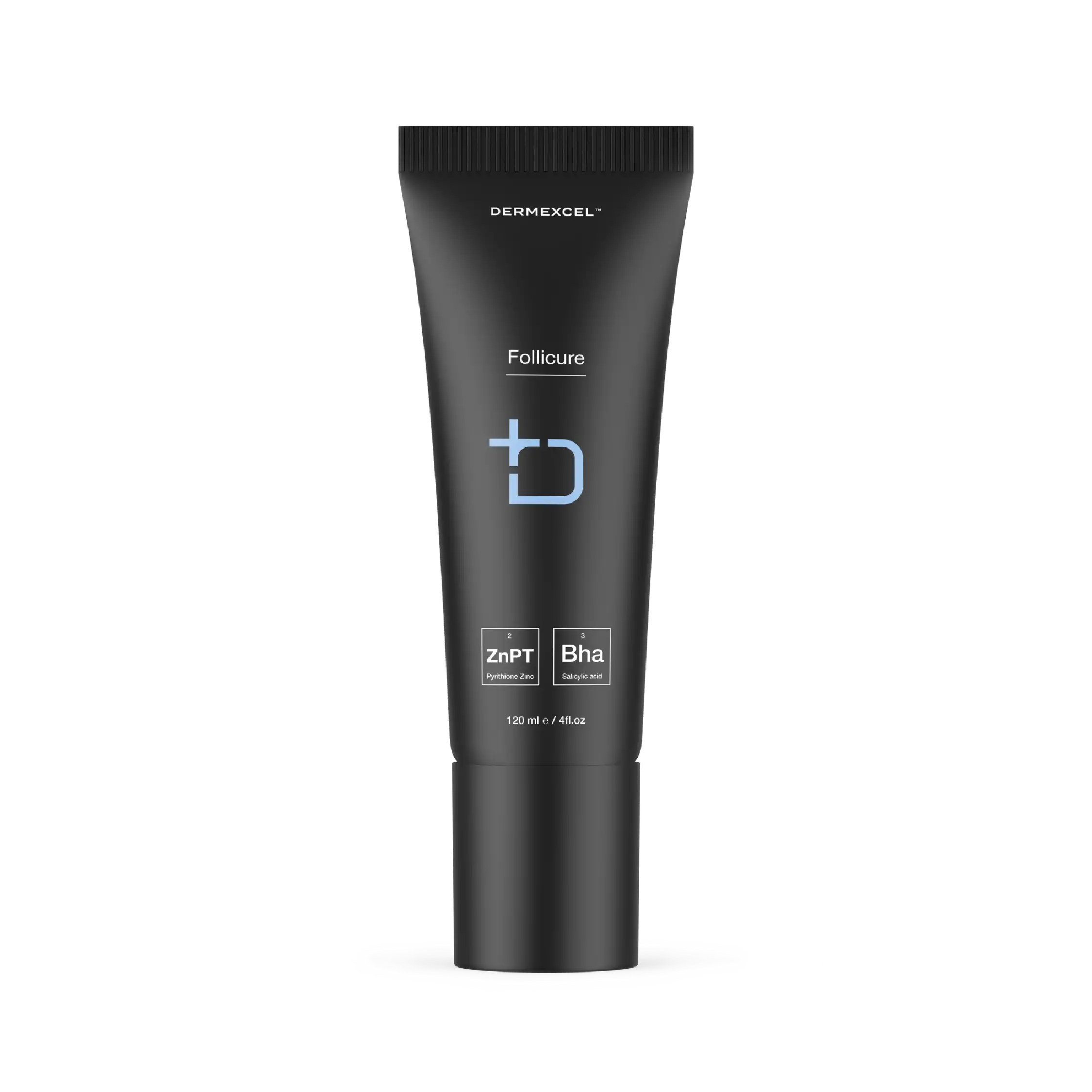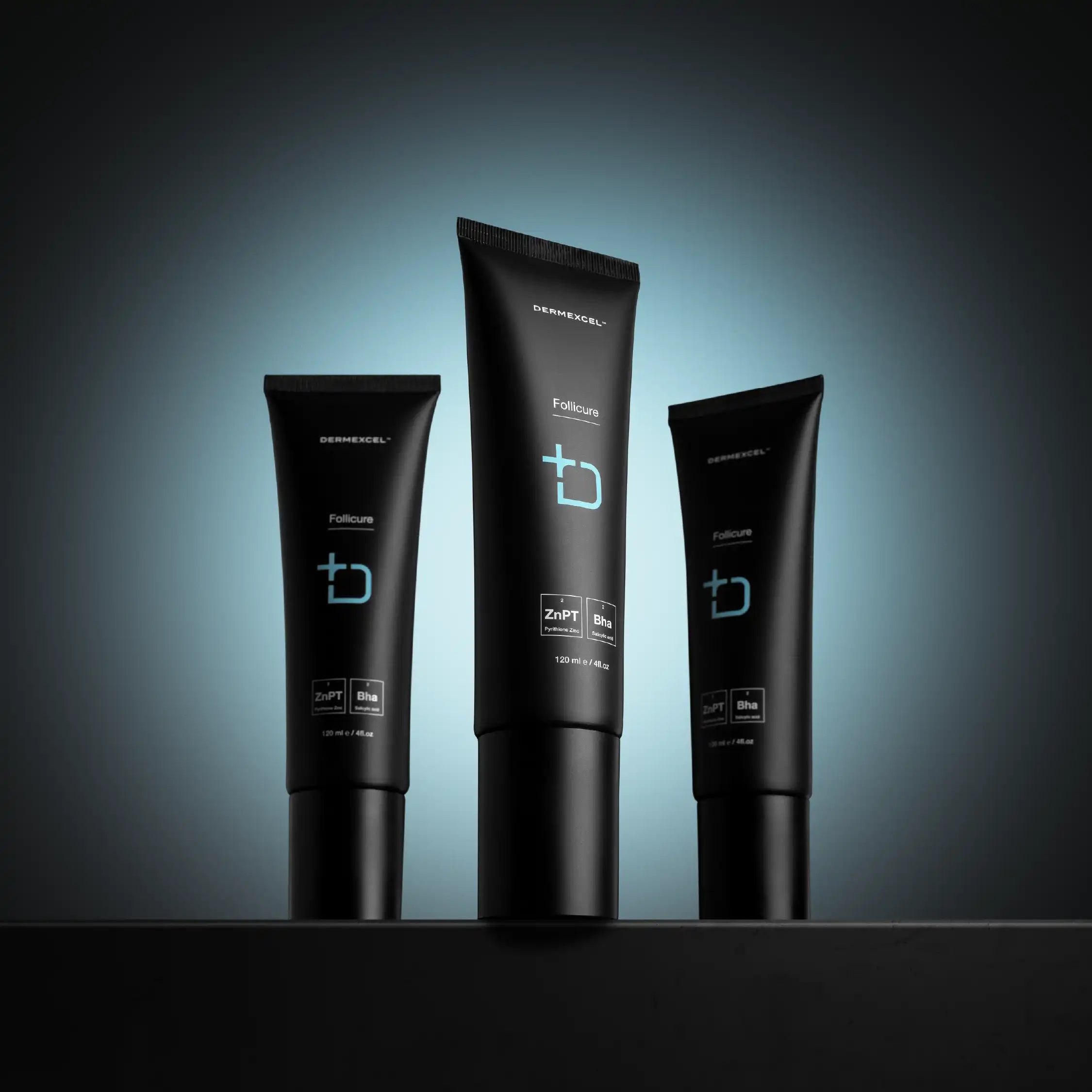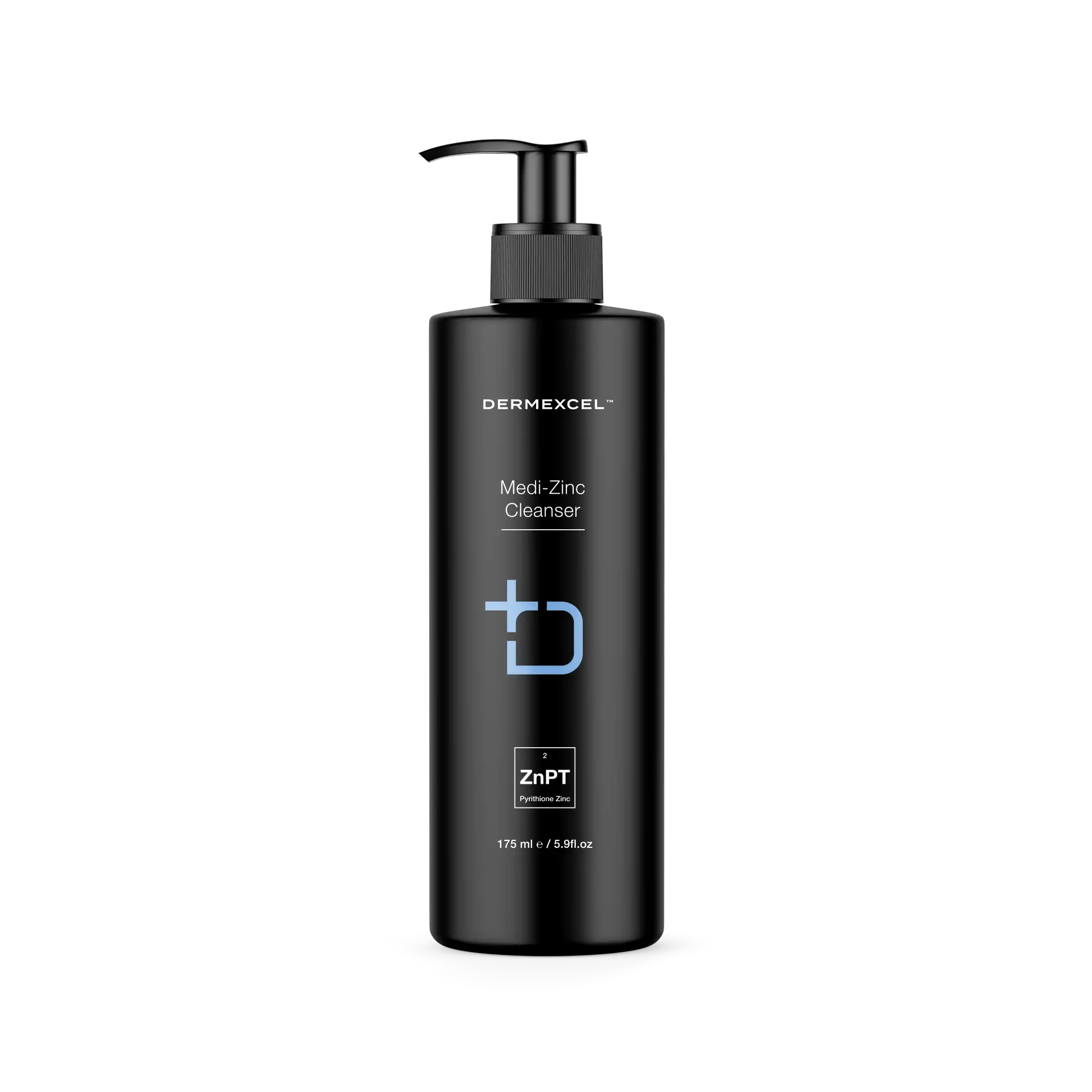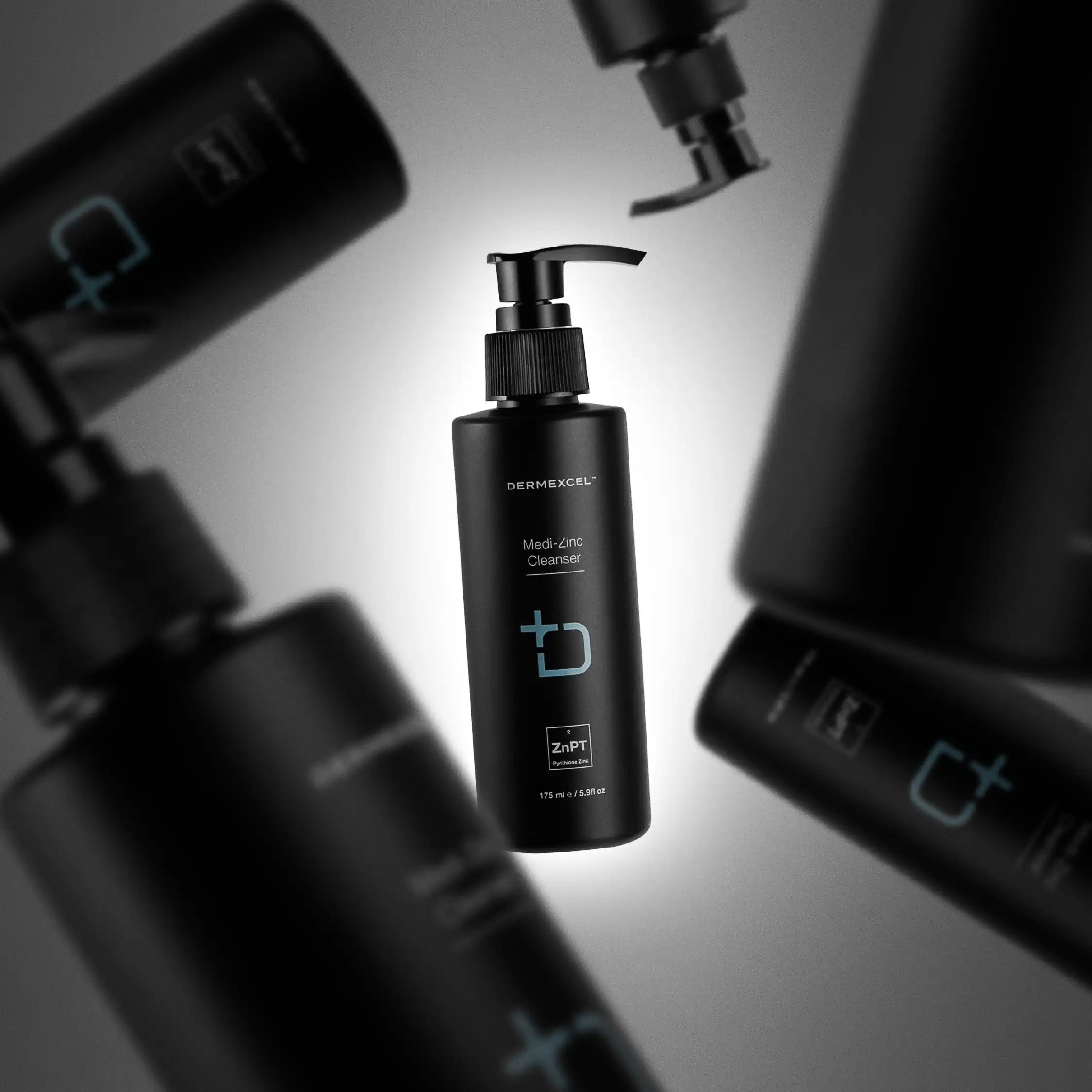Ingredient Focus: Zinc Pyrithione
Zinc Pyrithione is the active ingredient identified as being highly effective for treating and improving various skin conditions related to a natural yeast that lives on our skin called Malassezia.


Although it's part of our normal skin flora, Malassezia overgrowth can cause one or more of the following skin conditions:
- Dandruff
- Seborrheic dermatitis (red scaly patches of skin)
- Eczema
- Fungal Acne (also known as Malassezia Folliculitis)
- Psoriasis
- Rosacea
- Tinea Versicolor etc.


Zinc Pyrithione disrupts iron distribution across the yeast wall and effectively starves the yeast of some of the critical processes important in its respiratory function.
Zinc Pyrithione penetrates the hair follicle where Malassezia resides and has a unique slow-release ability. It persists in the top layer of skin even after rinsing off the product. Therefore, it imparts long-lasting control and sustained release of anti-yeast coverage and suppression of the Malassezia yeast overgrowth.
Zinc Pyrithione also has broad-spectrum antimicrobial activity: Not only does it inhibit and reduce the burden of Malassezia on the skin, but it also targets gram-positive and gram-negative bacteria, as well as other fungi that cause ringworm, athlete's foot, and jock itch.
Yeast, fungi, and bacteria do not develop resistance to Zinc Pyrithione. Consistent application of Zinc Pyrithione will, therefore, result in continuous antimicrobial activity.


You may experience one or more of the following symptoms:
- Red, inflamed, itchy skin on your body, scalp, or face.
- Crusty, scaly patches on the scalp.
- Skin flakes (dandruff) on your scalp, hair, eyebrows, beard, or mustache.
- Patches of greasy skin covered with flaky white or yellow scales or crust on the scalp, face, sides of the nose, eyebrows, ears, eyelids, chest, armpits, groin area or under the breasts.
- Little itchy bumps.
- Acne breakouts that do not seem to clear up with conventional acne treatment.
- Acne breakouts in moist areas ex: In the hairline, around the mouth, on the back, between the thighs, or on the buttocks.
Use a product that contains 2% Zinc Pyrithione
Make sure that the product has good contact with the skin. Lather the areas you would like to treat and keep the product on the skin for at least 5 minutes, but most preferably 10 minutes, for best results. This will allow the product to penetrate the follicles and reach the Malassezia optimally.
Repeat the application nightly for at least 3-4 weeks. Within this timeframe, you will start to experience positive results as the Zinc Pyrithione controls the Malassezia overgrowth.
To keep the Malassezia yeast from returning, make sure you have enough Zinc Pyrithione hanging out in the skin around the problem areas. Do not stop your treatment after all the signs and symptoms have cleared up. Problem areas should be in contact with Zinc Pyrithione at least once per week. Always remember the 5-10 min skin contact rule.
The FDA has approved Zinc Pyrithione as very safe and effective. There is no harm in continuing to use the Zinc Pyrithione daily. Bacteria and the yeast on your skin will not become resistant to it, so there's no reason to stop using it.
DermExcel products with Zinc Pyrithione






SIZE: 120 mL

healthy scalp

anti-dundruff

↓ inflammation

oil control

Itch Relief
A maximum-strength medicated scalp treatment relieves the itching, irritation, redness, flaking, and scaling associated with dandruff and seborrheic dermatitis.
A powerful formula that combines 2% Salicylic acid and 2% Zinc Pyrithione for maximum effectiveness and life-changing results.
Zinc Pyrithione, an antifungal, antimicrobial, and antibacterial agent, works by reducing the amount of fungus that triggers inflammation and scaling. Zinc Pyrithione also treats pityrosporum folliculitis (fungal acne) on the face and other body parts.
Salicylic acid gently exfoliates the scalp, removing dead skin cells and excess oil, contributing to dandruff and itchiness. As a result, it unclogs hair follicles, promoting a healthier scalp environment.
Zinc Pyrithione
Zinc pyrithione, a compound with potent antifungal and antibacterial properties, has established itself as a cornerstone in the treatment of various skin conditions, particularly those involving Malassezia yeast. Its effectiveness against seborrheic dermatitis and dandruff, which are often associated with an overgrowth of Malassezia species, makes it a key ingredient for many dermatological conditions.
Zinc pyrithione’s mode of action is multifaceted, primarily targeting the membrane of fungi and bacteria, thereby disrupting their growth and replication. One of its significant mechanisms involves inhibiting fungal cell membrane transport by blocking the energy production pathway, which is crucial for cell survival.
In Malassezia, yeast, a natural inhabitant of the skin flora, can overgrow and cause conditions like seborrheic dermatitis and dandruff; zinc pyrithione's antifungal action is particularly beneficial. It reduces the yeast population on the skin, thereby alleviating the symptoms associated with its overgrowth, such as flaking, irritation, and redness.
Its efficacy in treating seborrheic dermatitis is attributed to its ability to reduce the Malassezia count, diminish inflammatory responses, and soothe the skin. Similarly, in dandruff, which is often linked to an excess of Malassezia, zinc pyrithione effectively reduces flaking and itchiness, promoting a healthier scalp environment.
The efficacy of zinc pyrithione in the treatment of seborrheic dermatitis and dandruff is well-documented. Its safety profile and efficacy have been confirmed by numerous studies, with significant improvements observed in both scalp and skin conditions following regular use.
Physiological Effects
- Antifungal Activity: It is effective against a range of fungi, including those that cause dandruff and seborrheic dermatitis. Zinc Pyrithione inhibits the division of fungal cells, reducing their proliferation.
- Antibacterial Properties: This compound also exhibits antibacterial activity, making it useful in treating and preventing bacterial skin infections.
- Anti-inflammatory Effects: Zinc Pyrithione can reduce inflammation, which is beneficial in alleviating symptoms of various inflammatory skin conditions.
- Sebum Regulation: It helps in regulating sebum production, which can be beneficial for oily skin and conditions like acne.
Managing Dermatological Conditions
- Dandruff and Seborrheic Dermatitis: Zinc Pyrithione is a common ingredient in anti-dandruff shampoos and is effective in controlling the flaking and itching associated with these conditions.
- Psoriasis: It can help manage the symptoms of psoriasis, particularly in reducing scaling and redness.
- Acne: Due to its antibacterial and anti-inflammatory properties, Zinc Pyrithione can be beneficial in the treatment of acne.
- Fungal Infections: It is effective in treating various fungal skin infections due to its antifungal properties.
References
- Warshaw, E. M., et al. (2005). Efficacy of Zinc Pyrithione in Seborrheic Dermatitis and Dandruff. Dermatology.
- Pierard-Franchimont, C., et al. (2002). Antidandruff shampoo efficacy in dandruff/seborrhoeic dermatitis. International Journal of Cosmetic Science.
- Scheman, A., et al. (2000). Antimicrobial Activity of Zinc Pyrithione. American Journal of Infection Control.
Salicylic acid
Salicylic acid, a renowned beta hydroxy acid (BHA), is a cornerstone in dermatology and skincare due to its exceptional keratolytic and comedolytic properties. Its unique ability to penetrate oil-laden hair follicle pores makes it particularly effective in treating acne-prone and oily skin types.
Salicylic acid dissolves skin debris (sebum and dead skin cells) that clogs pores and causes acne. It's a mild antibacterial and powerful anti-inflammatory agent that helps reduce the redness and swelling associated with breakouts.
What sets salicylic acid apart in dermatological treatments is its ability to exfoliate the skin, not just on the surface but within the pores themselves. This is due to its oil-soluble nature, which allows it to penetrate deep into the pores and dissolve the keratin plugs that lead to blackheads and whiteheads.
Furthermore, salicylic acid also has the capacity to adjust the pH of the skin, creating an environment less favorable for the growth of acne-causing bacteria. Salicylic acid's efficacy in treating various skin conditions, particularly acne, has been extensively documented in the scientific literature. Studies have consistently shown its ability to reduce acne lesions in terms of count and severity. Additionally, Salicylic acid is highly recommended for its effectiveness in treating other skin conditions, such as psoriasis and dandruff, due to its ability to soften and remove scales and flakes from the skin.
Physiological Effects
- Keratolytic Action: Salicylic acid is known for its ability to exfoliate the skin by dissolving the intercellular 'glue' that holds skin cells together, helping to remove dead skin cells and unclog pores.
- Comedolytic Effect: It is particularly effective in reducing comedones (blackheads and whiteheads) by unclogging pores and preventing the formation of new comedones.
- Anti-inflammatory Properties: Salicylic acid reduces inflammation, which is beneficial in treating acne and other inflammatory skin conditions.
- Sebum Regulation: It helps to regulate oil production, making it a valuable ingredient for managing oily and acne-prone skin.
- Penetration Enhancement: Due to its lipophilic nature, it can penetrate sebum-filled follicles, effectively treating acne located deep within the pores.
Managing Dermatological Conditions
- Acne Vulgaris: Salicylic acid is a cornerstone in acne treatment, effectively preventing and treating existing acne lesions.
- Psoriasis: Its keratolytic properties make it helpful in softening and removing scales associated with psoriasis.
- Warts: Salicylic acid is commonly used to treat warts because it can exfoliate and remove the thickened skin.
- Seborrheic Dermatitis: It helps manage seborrheic dermatitis by reducing scaling and redness.
- Keratosis Pilaris: Salicylic acid can aid in smoothing the rough bumps associated with keratosis pilaris.
References
- Zaenglein, A. L., Pathy, A. L., Schlosser, B. J., Alikhan, A., Baldwin, H. E., Berson, D. S., & Thiboutot, D. M. (2016). Guidelines of care for the management of acne vulgaris. Journal of the American Academy of Dermatology, 74(5), 945-973.e33.
- Kornhauser, A., Coelho, S. G., & Hearing, V. J. (2010). Applications of hydroxy acids: classification, mechanisms, and photoactivity. Clinical, cosmetic and investigational dermatology, 3, 135.
- Zander, E., & Weisman, S. (1992). Treatment of acne vulgaris with salicylic acid pads. Clinical Therapeutics.
- Gupta, A. K., & Nicol, K. (2004). The use of sulfur in dermatology. Journal of Drugs in Dermatology.








Itch Relief

Anti-Acne

↓ inflammation

anti-redness

Anti-microbial
A powerful hypoallergenic medicated solution with beneficial properties attributed to its active constituent, Zinc Pyrithione. This chemical compound, FDA-approved and clinically recognized, delivers strong antibacterial and antifungal action, making the cleanser an ideal choice for managing skin conditions associated with redness, flaking, irritation, and itching.
Zinc Pyrithione's efficacy, compounded by a gentle cleansing base, facilitates the lifting and removing of impurities, leaving the complexion refreshed. Concurrently, it sustains a tranquil skin environment, reducing inflammation and discomfort. As a daily cleansing aid, Medi-Zinc Cleanser proposes a reliable, scientifically-backed intervention in fostering skin health and comfort.
Zinc Pyrithione
Zinc pyrithione, a compound with potent antifungal and antibacterial properties, has established itself as a cornerstone in the treatment of various skin conditions, particularly those involving Malassezia yeast. Its effectiveness against seborrheic dermatitis and dandruff, which are often associated with an overgrowth of Malassezia species, makes it a key ingredient for many dermatological conditions.
Zinc pyrithione’s mode of action is multifaceted, primarily targeting the membrane of fungi and bacteria, thereby disrupting their growth and replication. One of its significant mechanisms involves inhibiting fungal cell membrane transport by blocking the energy production pathway, which is crucial for cell survival.
In Malassezia, yeast, a natural inhabitant of the skin flora, can overgrow and cause conditions like seborrheic dermatitis and dandruff; zinc pyrithione's antifungal action is particularly beneficial. It reduces the yeast population on the skin, thereby alleviating the symptoms associated with its overgrowth, such as flaking, irritation, and redness.
Its efficacy in treating seborrheic dermatitis is attributed to its ability to reduce the Malassezia count, diminish inflammatory responses, and soothe the skin. Similarly, in dandruff, which is often linked to an excess of Malassezia, zinc pyrithione effectively reduces flaking and itchiness, promoting a healthier scalp environment.
The efficacy of zinc pyrithione in the treatment of seborrheic dermatitis and dandruff is well-documented. Its safety profile and efficacy have been confirmed by numerous studies, with significant improvements observed in both scalp and skin conditions following regular use.
Physiological Effects
- Antifungal Activity: It is effective against a range of fungi, including those that cause dandruff and seborrheic dermatitis. Zinc Pyrithione inhibits the division of fungal cells, reducing their proliferation.
- Antibacterial Properties: This compound also exhibits antibacterial activity, making it useful in treating and preventing bacterial skin infections.
- Anti-inflammatory Effects: Zinc Pyrithione can reduce inflammation, which is beneficial in alleviating symptoms of various inflammatory skin conditions.
- Sebum Regulation: It helps in regulating sebum production, which can be beneficial for oily skin and conditions like acne.
Managing Dermatological Conditions
- Dandruff and Seborrheic Dermatitis: Zinc Pyrithione is a common ingredient in anti-dandruff shampoos and is effective in controlling the flaking and itching associated with these conditions.
- Psoriasis: It can help manage the symptoms of psoriasis, particularly in reducing scaling and redness.
- Acne: Due to its antibacterial and anti-inflammatory properties, Zinc Pyrithione can be beneficial in the treatment of acne.
- Fungal Infections: It is effective in treating various fungal skin infections due to its antifungal properties.
References
- Warshaw, E. M., et al. (2005). Efficacy of Zinc Pyrithione in Seborrheic Dermatitis and Dandruff. Dermatology.
- Pierard-Franchimont, C., et al. (2002). Antidandruff shampoo efficacy in dandruff/seborrhoeic dermatitis. International Journal of Cosmetic Science.
- Scheman, A., et al. (2000). Antimicrobial Activity of Zinc Pyrithione. American Journal of Infection Control.




















